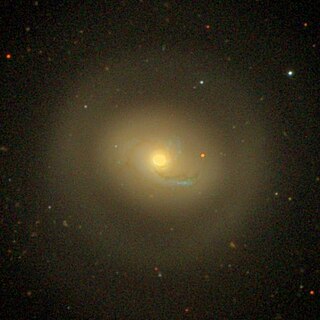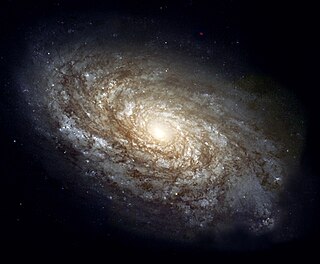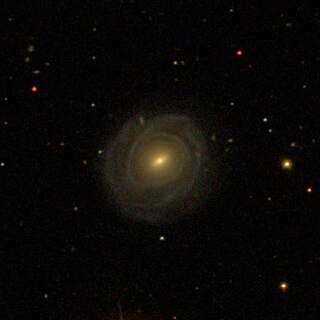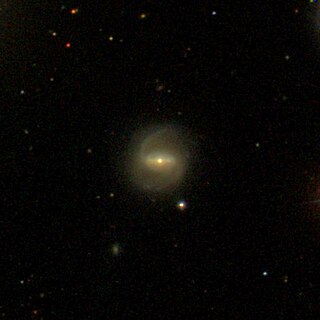
NGC 4309 is a lenticular galaxy located about 55 million light-years away in the constellation Virgo. The galaxy was discovered by astronomer Christian Peters in 1881 and is a member of the Virgo Cluster.

NGC 4457 is an intermediate spiral galaxy located about 55 million light-years away in the constellation of Virgo. It is also classified as a LINER galaxy, a class of active galaxy defined by their spectral line emissions. NGC 4457 Is inclined by about 33°. It was discovered by astronomer William Herschel on February 23, 1784. Despite being listed in the Virgo Cluster Catalog as VCC 1145, NGC 4457 is a member of the Virgo II Groups which form an extension of the Virgo cluster.

NGC 4492 is a spiral galaxy located about 90 million light-years away in the constellation Virgo. NGC 4492 was discovered by astronomer William Herschel on December 28, 1785. It was rediscovered by astronomer Arnold Schwassmann on January 23, 1900, and was listed as IC 3438. NGC 4492 lies in the direction of the Virgo Cluster. However, it is not considered to be a member of that cluster.

NGC 4596 is a barred lenticular galaxy located about 55 million light-years away in the constellation Virgo. NGC 4596 was discovered by astronomer William Herschel on March 15, 1784. NGC 4596 is a member of the Virgo Cluster and has an inclination of about 38°.

NGC 4607 is an edge-on spiral galaxy located about 56 million light-years away in the constellation Virgo. NGC 4607 was discovered by astronomer R. J. Mitchell on April 24, 1854. The galaxy is a member of the Virgo Cluster.

NGC 4660 is an elliptical galaxy located about 63 million light-years away in the constellation Virgo. The galaxy was discovered by astronomer William Herschel on March 15, 1784 and is a member of the Virgo Cluster.

The Coma I Group is a group of galaxies located about 14.5 Mpc (47.3 Mly) away in the constellation Coma Berenices. The brightest member of the group is NGC 4725. The Coma I Group is rich in spiral galaxies while containing few elliptical and lenticular galaxies. Coma I lies in the foreground of the more distant Coma and Leo clusters and is located within the Virgo Supercluster.

NGC 4222 is an edge-on spiral galaxy located about 60 million light-years away in the constellation Coma Berenices. It was discovered by astronomer William Herschel on April 8, 1784 and is often misidentified as IC 3087. NGC 4222 is a member of the Virgo Cluster and is a companion of NGC 4216 which lies about 180,000 ly (56 kpc) away. Despite this, the two galaxies are not interacting.

NGC 4237 is a flocculent spiral galaxy located about 60 million light-years away in the constellation Coma Berenices. The galaxy was discovered by astronomer William Herschel on December 30, 1783 and is a member of the Virgo Cluster. It is also classified as a LINER galaxy and as a Seyfert galaxy.

NGC 4294 is a barred spiral galaxy with flocculent spiral arms located about 55 million light-years away in the constellation Virgo. The galaxy was discovered by astronomer William Herschel on March 15, 1784 and is a member of the Virgo Cluster.

NGC 4298 is a flocculent spiral galaxy located about 53 million light-years away in the constellation Coma Berenices. The galaxy was discovered by astronomer William Herschel on April 8, 1784 and is a member of the Virgo Cluster.

NGC 4299 is a featureless spiral galaxy located about 55 million light-years away in the constellation Virgo. It was discovered by astronomer William Herschel on March 15, 1784 and is a member of the Virgo Cluster.

NGC 4302 is an edge-on spiral galaxy located about 55 million light-years away in the constellation Coma Berenices. It was discovered by astronomer William Herschel on April 8, 1784 and is a member of the Virgo Cluster.

NGC 4305 is a dwarf spiral galaxy located about 100 million light-years away in the constellation Virgo. The galaxy was discovered by astronomer John Herschel on May 2, 1829. Although considered to be a member of the Virgo Cluster, its high radial velocity and blue luminosity suggest it is in fact a background galaxy. The galaxy has a nearby major companion; NGC 4306.

NGC 4306 is a dwarf barred lenticular galaxy located about 100 million light-years away in the constellation Virgo. The galaxy was discovered by astronomer Heinrich d'Arrest on April 16, 1865. Although considered to be a member of the Virgo Cluster, its high radial velocity and similar distance as NGC 4305 suggest that NGC 4306 is a background galaxy. NGC 4306 is a companion of NGC 4305 and appears to be interacting with it.

NGC 4307 is an edge-on spiral galaxy located about 65 million light-years away in the constellation Virgo. It was discovered by astronomer Christian Peters in 1881 and is a member of the Virgo Cluster. It is also a LINER galaxy.

NGC 4318 is a small lenticular galaxy located about 72 million light-years away in the constellation Virgo. It was discovered by astronomer John Herschel on January 18, 1828. NGC 4318 is a member of the Virgo W′ group, a group of galaxies in the background of the Virgo Cluster that is centered on the giant elliptical galaxy NGC 4365.

NGC 4324 is a lenticular galaxy located about 85 million light-years away in the constellation Virgo. It was discovered by astronomer Heinrich d'Arrest on March 4, 1862. NGC 4324 has a stellar mass of 5.62 × 1010M☉, and a baryonic mass of 5.88 × 1010M☉. The galaxy's total mass is around 5.25 × 1011M☉. NGC 4324 is notable for having a ring of star formation surrounding its nucleus. It was considered a member of the Virgo II Groups until 1999, when its distance was recalculated and it was placed in the Virgo W Group.

NGC 4326 is a barred spiral galaxy with a ring located about 330 million light-years away in the constellation Virgo. It was discovered by astronomer William Herschel on April 13, 1784, who described it as "vF, S, R, bM, 1st of 3". It is a large galaxy, with a diameter of around 200,000 ly (61 kpc) making it nearly twice the size of the Milky Way. NGC 4326 is also classified as a LINER galaxy. Despite being listed in the Virgo Cluster catalog as VCC 623, it is not a member of the Virgo Cluster but instead a background galaxy.

NGC 4333 is a barred spiral galaxy with a ring structure located about 330 million light-years away in the constellation Virgo. It was discovered by astronomer William Herschel on April 13, 1784, who described it as "F, pS, R, bM, 2nd of 3". NGC 4333 is also classified as a LINER galaxy. Despite being listed in the Virgo Cluster catalog as VCC 637, it is not a member of the Virgo Cluster but instead a background galaxy.




















